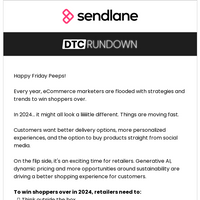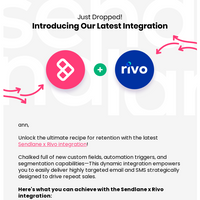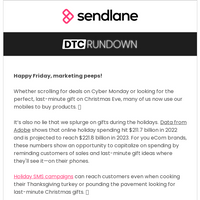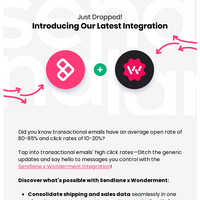
Cha-ching! 💰
Ahh, the sweet sound of a customer completing a purchase.
As an eCommerce vendor, this is music to your ears.
But how did the customer get to that point? What made them bite the bullet and head to the checkout? 🤔
You may think it was that recent marketing campaign for the new product launch. Or that automated email sequence you set up last month. Or maybe, just maybe, it was the Instagram post about the product a week ago that finally convinced them to buy.
The harsh truth is… without monitoringrevenue attribution and gathering data—it's all just a guess.
To figure out how somebody turned from visitor to paying customer, you must track their journey and attribute touchpoints to their buying decision.
So today, we’re diving a little deeper into how to do just that.
Before we jump in, we’ve got an exciting event on the horizon.
Mark your calendar for February 20th at 11:00 am PST and join us for for theGiveaway Growth Hacks Webinarwhere Shared Sweeps Founder, Craig Martens, and Sendlane Founder & CIO, Jimmy Kim will unravel the secrets behind using giveaways.
Learn how to to leverage giveaways to revolutionize customer engagement, boost brand loyalty, and drive sales.
Don’t miss out! Register here.
Now let’s get into it👇
How to Monitor Performance Using Revenue Attribiution

The Nuts and Bolts of Revenue Attribution (and Why It's Important)
Revenue attribution is when a business finds and tracks marketing touchpoints around customer actions, such as clicks, behaviors or conversions, to attach them to purchases.
In more basic terms, revenue attribution helps vendors pinpoint when someone looked at a product or service and turned into a paying customer. 💸
There are five revenue attribution models generally used in eCommerce marketing:
👉
First-touch/last-touch: The full value of a customer's purchase is attributed to the first/last touchpoint they interacted with. It's useful to pinpoint where a customer developed their first interest in your product, and what touchpoint may have convinced them to checkout.
✔️
Linear: Each touchpoint in the customer's journey to the checkout is given equal credit. Whether a customer liked an Instagram post of a pair of jeans or clicked on the website to checkout sizing and your returns policy, both touchpoints get a tick in the attribution checkbox.
🕣
Time decay:With time decay, whatever channels the customer interacted with closest to their purchase get the attribution credit.
📊
Position-based: This model assumes not every customer touchpoint is equal. The position-based attribution system helps marketing teams to focus on channels that play a bigger role to drive customers to the checkout.
🚀
Campaign attribution: The clue is in the name. This attribution model looks at which marketing channels and campaigns contribute most to conversions and sales. It's useful to see what part of a campaign is most effective.
Even if you track all of these, sometimes the numbers don't add up and the tech we use doesn't tell the full story.
Vendors can collect, slice, and dice revenue attribution data to tell almost any story you want. But data is the key to accurate attribution. And you need as much of it as possible to see what strategies are working (and what's not) to avoid giving attribution credit where it’s not due.
A Simple Example of Revenue Attribution
Picture this: You live near a superstore where you do a weekly grocery shop. 🛒
The store has everything you want, and it's part of your weekly routine as you go every Friday after work. One Friday on your way to do the shopping, you pass a billboard advertising the store—but you didn't notice it as you were thinking about your grocery list.
Here comes therevenue attribution question—should the billboard get credit for this weekly grocery shop? 🤔
Technically, you passed the billboard and then entered the store to do your grocery shopping. On paper, the superstore owner may think the billboard convinced you to come inside.
What this assumption doesn't take into account is that you're a regular shopper and you took the same road you always do, but the billboard just happened to be there that Friday.
There is no way to know for sure that the billboard was the deciding factor for you stepping into the superstore.
The same principle applies to email and SMS marketing when a vendor pieces together revenue attribution. If someone receives an email from you, clicks a link, and then buys something a week later—is the email responsible for the sale?
It's possible. But not definite.
Sendlane's customizable attribution puts you in command, allowing you to fine-tune your attribution settings based on your specific business requirements. Whether you prefer to align with your existing platforms or diverge from our default attribution windows, the power is in your hands.
Forrevenue attribution to work, vendors must make assumptions about a customer's intentions, but it's up to you to decide what's reasonable. And that's where third party data comes in.
Let's take a look at how that happens 👇
Why Third-Party Data Matters for Revenue Attribution
Third-party data can act as an eCommerce store's north star.
It tracks where, when, and how a visitor turns into a paying customer. Third party data can dive deep into a store's sales funnel, individual touchpoints and marketing campaigns and help verify what internal metrics are telling you.
This is super important because every single email, SMS, and eCommerce provider attributes revenue in different ways and uses different parameters—and a ton of different data gets used.
Vendors must learn how every metric fits into their attribution calculation and then bring all that data together under one roof to make sense of it.
Without a source of truth, you don't know which data point is accurate.
For example, if we (yep, us here at Sendlane 👋) tell a vendor our email marketing platform is responsible for bringing in $5000 of revenue in a previous campaign, we gotta back it up.
Here's a typical example from a customer:
🚀
A vendor creates and sends out a email campaign with a unique discount code.
📧
The email lands in the customer's inbox and they see the unique code. However, it's hard to track email opens because a lot of customers use inbox providers or special settings that block the tracking pixel.
💰
Customers buy the product mentioned in the email, but more orders use the unique code at the checkout compared to the email campaigns' opens/clicks.
Here's what all that data tells us. 👇
Because the code was unique to the email campaign, we know for sure that it was responsible for a big chunk of the orders. While the usage rate of the code may not be visible in the campaign email report, the revenue can be tied back to the unique code.
So, we can be confident in attributing the $5k to the email campaign launched on Sendlane. But the vendor can also check the $ figure using a third-party revenue analytics tool to make sure.
Generally, if revenue trends are a steady third-party source can track against what your main eCommerce platform is telling you—it's a great sign your marketing strategy is working. 🔥
Pro-Tip: Stick to Simple Revenue Attribution Metrics
When it comes to metrics, we always tell vendors to stick to the basics.
A ton of advice out there will tell you to track everything from list growth to bounce rates. But tracking bread and butter metrics, like clicks and opens, has its perks. Therevenue attribution data gathered from these two sources is about as realistic and accurate as it gets.

How to Set Up (and Use) Third-Party Data
Step 1. Think about your needs
Not all third-party data providers are built the same.
Some are a great fit for larger eCommerce stores, while others have features specifically targeted at small vendors. Before selecting a third-party data provider, you must first determine your specific data needs and goals and think about what kind of information will help grow your eCommerce.
To figure this out, ask questions like:
👉
What type of data would be helpful for my marketing strategy, and the eCommerce as a whole?
👉
Are there any particular insights or demographic information I need?
👉
How will this data support my overall marketing and sales strategies?
The answers will help steer you to the right third-party data platform for your needs.
Step 2. Pick a Third-Party Data Provider
Next, look at what third data providers are out there and narrow down which one would be a good fit for your eCommerce store.
Look for a data platform that not only has a track record of delivering accurate data, but also gathers it from a variety of sources. At Sendlane, we recommend using a third-party eCommerce data analytics service like Triple Whale, Northbeam, or Google Analytics.
These providers act as a source of truth and bring all of your individual marketing channel data together under one roof so you can make sense of it.
Step 3. Check the Integrations
But before you invest in a third-party data tool, make sure to take a good look at its integration methods.
Depending on the third-party provider, you may be able to integrate it into your eCommerce platform using file transfers, direct APIs, or webhooks. Most of this will be done by an IT team, but it's important to look at the integrations before you go all-in on a third-party tool, otherwise there may be problems adding to your tech stack down the road.
Oh, and if there are problems, any third-party platform worth its salt will help you work through them. If not, don't be afraid to take your budget elsewhere and spend it on a tool that will.
Pro-tip:Integrating third-party data is an ongoing process, and regular monitoring and optimization are necessary for valuable insight—but do your (security) homework. Check with your existing eCommerce tech stack that the third-party data doesn't have any legal, privacy, and security implications. Cover your back and make sure you comply with any relevant regulations.
Step 4. Test and Validate the Third-Party Data Tool
Once the third-party tool is integrated, put it through its paces.
👉
Validate everything: Check your data to make sure it accurately transfers into your eCommerce platform. It's a good idea to monitor any product information, campaign metrics, pricing, and other data points to ensure they are correctly synced.
👉
Check consistency: Keep a close eye on the data sync process to ensure consistent updates. Monitor any data discrepancies or errors during the integration process (or at least the first couple of weeks).
👉
Troubleshoot any issues: If data is incorrect or not syncing correctly, work with your third-party data's technical support team to sort it out ASAP.
Once everything is up and running, you should have access to accurate, cross-referenced data to help make better marketing decisions for your eCommerce.
For example, heres what Sendlane’s attribution dashboard looks like:

You can check which campaigns brought in the most revenue and what links were clicked in each email. Typically, marketers will use this data to try and map out a customer journey.
If a customer was sent an email on Tuesday, opened it on Wednesday, and then used a link in the email to order a product on Friday—it's a pretty simple customer journey.
But not all campaigns are that cut and dry. And that's why vendors should use third-party data to fill in the gaps.
For example, a platform likeTriple Whale offers tools that can weigh marketing channels like Facebook against ad spend, impressions, and purchases to see if a campaign is winning or losing.
This not only helps marketers like you track where customers are coming from, but also gives you truthful data around what messages and campaigns bring in the most revenue.

When you use a third-party service like this with a powerful eCommerce marketing tool like Sendlane, it creates a reservoir of valuable data. You can connect all of your marketing efforts to one platform, track every dollar spent, and get a crystal clear picture of what customers want.
Leverage Insights from Revenue Attribution to Optimize Your Marketing Strategy
Keeping a close eye onrevenue attribution is crucial for unlocking the true potential of your marketing efforts.
Whether you favor first-touch or linear models, understanding the customer journey is a must.
Remember, the numbers may not always align, but the key to optimization lies in the data—From here you can discern what strategies truly drive success.
As always, thanks for tuning in to this week's DTC Rundown.
Same time, same place next Friday! 👋
|
NL How to make the most of third-party data͏ ͏ ͏ ͏ ͏ ͏ ͏ ͏ ͏ ͏ ͏ ͏ ͏ ͏ ͏ ͏ ͏ ͏ ͏ ͏ ͏ ͏ ͏ ͏ ͏ ͏ ͏ ͏ ͏ ͏ ͏ ͏ ͏ ͏ ͏ ͏ ͏ ͏ ͏ ͏ ͏ ͏ ͏ ͏ ͏ ͏ ͏ ͏ ͏ ͏ ͏ ͏ ͏ ͏ ͏ ͏ ͏ ͏ ͏ ͏ ͏ ͏ ͏ ͏ ͏ ͏ ͏ ͏ ͏ ͏ ͏ ͏ ͏ ͏ ͏ ͏ ͏ ͏ ͏ ͏ ͏ ͏ ͏ ͏ ͏ ͏ ͏ ͏ ͏ ͏ ͏ ͏ ͏ ͏ ͏ ͏ ͏ ͏ ͏ ͏ ͏ ͏ ͏ ͏ ͏ ͏ ͏ ͏ ͏ ͏ ͏ ͏ ͏ ͏ ͏ ͏ ͏ ͏ ͏ ͏ ͏ ͏ ͏ ͏ ͏ ͏ ͏ ͏ ͏ ͏ ͏ ͏ ͏ ͏ ͏ ͏ ͏ ͏ ͏ ͏ ͏ ͏ ͏ ͏ ͏ ͏ ͏ ͏ ͏ ͏ ͏ ͏ ͏ ͏ ͏ ͏ ͏ ͏ ͏ ͏ Cha-ching! 💰Ahh, the sweet sound of a customer completing a purchase.As an eCommerce vendor, this is music to your ears.But how did the customer get to that point? What made them bite the bullet and head to the checkout? 🤔You may think it was that recent marketing campaign for the new product launch. Or that automated email sequence you set up last month. Or maybe, just maybe, it was the Instagram post about the product a week ago that finally convinced them to buy.The harsh truth is… without monitoringrevenue attribution and gathering data—it's all just a guess.To figure out how somebody turned from visitor to paying customer, you must track their journey and attribute touchpoints to their buying decision.So today, we’re diving a little deeper into how to do just that.Before we jump in, we’ve got an exciting event on the horizon.Mark your calendar for February 20th at 11:00 am PST and join us for for theGiveaway Growth Hacks Webinarwhere Shared Sweeps Founder, Craig Martens, and Sendlane Founder & CIO, Jimmy Kim will unravel the secrets behind using giveaways.Learn how to to leverage giveaways to revolutionize customer engagement, boost brand loyalty, and drive sales. Don’t miss out! Register here.Now let’s get into it👇 How to Monitor Performance Using Revenue Attribiution The Nuts and Bolts of Revenue Attribution (and Why It's Important)Revenue attribution is when a business finds and tracks marketing touchpoints around customer actions, such as clicks, behaviors or conversions, to attach them to purchases.In more basic terms, revenue attribution helps vendors pinpoint when someone looked at a product or service and turned into a paying customer. 💸There are five revenue attribution models generally used in eCommerce marketing: 👉First-touch/last-touch: The full value of a customer's purchase is attributed to the first/last touchpoint they interacted with. It's useful to pinpoint where a customer developed their first interest in your product, and what touchpoint may have convinced them to checkout.✔️Linear: Each touchpoint in the customer's journey to the checkout is given equal credit. Whether a customer liked an Instagram post of a pair of jeans or clicked on the website to checkout sizing and your returns policy, both touchpoints get a tick in the attribution checkbox. 🕣Time decay:With time decay, whatever channels the customer interacted with closest to their purchase get the attribution credit. 📊Position-based: This model assumes not every customer touchpoint is equal. The position-based attribution system helps marketing teams to focus on channels that play a bigger role to drive customers to the checkout.🚀Campaign attribution: The clue is in the name. This attribution model looks at which marketing channels and campaigns contribute most to conversions and sales. It's useful to see what part of a campaign is most effective. Even if you track all of these, sometimes the numbers don't add up and the tech we use doesn't tell the full story.Vendors can collect, slice, and dice revenue attribution data to tell almost any story you want. But data is the key to accurate attribution. And you need as much of it as possible to see what strategies are working (and what's not) to avoid giving attribution credit where it’s not due.A Simple Example of Revenue AttributionPicture this: You live near a superstore where you do a weekly grocery shop. 🛒The store has everything you want, and it's part of your weekly routine as you go every Friday after work. One Friday on your way to do the shopping, you pass a billboard advertising the store—but you didn't notice it as you were thinking about your grocery list.Here comes therevenue attribution question—should the billboard get credit for this weekly grocery shop? 🤔Technically, you passed the billboard and then entered the store to do your grocery shopping. On paper, the superstore owner may think the billboard convinced you to come inside.What this assumption doesn't take into account is that you're a regular shopper and you took the same road you always do, but the billboard just happened to be there that Friday. There is no way to know for sure that the billboard was the deciding factor for you stepping into the superstore. The same principle applies to email and SMS marketing when a vendor pieces together revenue attribution. If someone receives an email from you, clicks a link, and then buys something a week later—is the email responsible for the sale? It's possible. But not definite. Sendlane's customizable attribution puts you in command, allowing you to fine-tune your attribution settings based on your specific business requirements. Whether you prefer to align with your existing platforms or diverge from our default attribution windows, the power is in your hands.Forrevenue attribution to work, vendors must make assumptions about a customer's intentions, but it's up to you to decide what's reasonable. And that's where third party data comes in.Let's take a look at how that happens 👇Why Third-Party Data Matters for Revenue AttributionThird-party data can act as an eCommerce store's north star.It tracks where, when, and how a visitor turns into a paying customer. Third party data can dive deep into a store's sales funnel, individual touchpoints and marketing campaigns and help verify what internal metrics are telling you. This is super important because every single email, SMS, and eCommerce provider attributes revenue in different ways and uses different parameters—and a ton of different data gets used.Vendors must learn how every metric fits into their attribution calculation and then bring all that data together under one roof to make sense of it. Without a source of truth, you don't know which data point is accurate. For example, if we (yep, us here at Sendlane 👋) tell a vendor our email marketing platform is responsible for bringing in $5000 of revenue in a previous campaign, we gotta back it up.Here's a typical example from a customer: 🚀A vendor creates and sends out a email campaign with a unique discount code.📧The email lands in the customer's inbox and they see the unique code. However, it's hard to track email opens because a lot of customers use inbox providers or special settings that block the tracking pixel.💰Customers buy the product mentioned in the email, but more orders use the unique code at the checkout compared to the email campaigns' opens/clicks.Here's what all that data tells us. 👇Because the code was unique to the email campaign, we know for sure that it was responsible for a big chunk of the orders. While the usage rate of the code may not be visible in the campaign email report, the revenue can be tied back to the unique code.So, we can be confident in attributing the $5k to the email campaign launched on Sendlane. But the vendor can also check the $ figure using a third-party revenue analytics tool to make sure.Generally, if revenue trends are a steady third-party source can track against what your main eCommerce platform is telling you—it's a great sign your marketing strategy is working. 🔥Pro-Tip: Stick to Simple Revenue Attribution MetricsWhen it comes to metrics, we always tell vendors to stick to the basics.A ton of advice out there will tell you to track everything from list growth to bounce rates. But tracking bread and butter metrics, like clicks and opens, has its perks. Therevenue attribution data gathered from these two sources is about as realistic and accurate as it gets. How to Set Up (and Use) Third-Party DataStep 1. Think about your needsNot all third-party data providers are built the same. Some are a great fit for larger eCommerce stores, while others have features specifically targeted at small vendors. Before selecting a third-party data provider, you must first determine your specific data needs and goals and think about what kind of information will help grow your eCommerce. To figure this out, ask questions like:👉What type of data would be helpful for my marketing strategy, and the eCommerce as a whole?👉Are there any particular insights or demographic information I need?👉How will this data support my overall marketing and sales strategies?The answers will help steer you to the right third-party data platform for your needs. Step 2. Pick a Third-Party Data ProviderNext, look at what third data providers are out there and narrow down which one would be a good fit for your eCommerce store. Look for a data platform that not only has a track record of delivering accurate data, but also gathers it from a variety of sources. At Sendlane, we recommend using a third-party eCommerce data analytics service like Triple Whale, Northbeam, or Google Analytics.These providers act as a source of truth and bring all of your individual marketing channel data together under one roof so you can make sense of it. Step 3. Check the IntegrationsBut before you invest in a third-party data tool, make sure to take a good look at its integration methods. Depending on the third-party provider, you may be able to integrate it into your eCommerce platform using file transfers, direct APIs, or webhooks. Most of this will be done by an IT team, but it's important to look at the integrations before you go all-in on a third-party tool, otherwise there may be problems adding to your tech stack down the road. Oh, and if there are problems, any third-party platform worth its salt will help you work through them. If not, don't be afraid to take your budget elsewhere and spend it on a tool that will.Pro-tip:Integrating third-party data is an ongoing process, and regular monitoring and optimization are necessary for valuable insight—but do your (security) homework. Check with your existing eCommerce tech stack that the third-party data doesn't have any legal, privacy, and security implications. Cover your back and make sure you comply with any relevant regulations. Step 4. Test and Validate the Third-Party Data ToolOnce the third-party tool is integrated, put it through its paces. 👉Validate everything: Check your data to make sure it accurately transfers into your eCommerce platform. It's a good idea to monitor any product information, campaign metrics, pricing, and other data points to ensure they are correctly synced.👉Check consistency: Keep a close eye on the data sync process to ensure consistent updates. Monitor any data discrepancies or errors during the integration process (or at least the first couple of weeks).👉Troubleshoot any issues: If data is incorrect or not syncing correctly, work with your third-party data's technical support team to sort it out ASAP. Once everything is up and running, you should have access to accurate, cross-referenced data to help make better marketing decisions for your eCommerce.For example, heres what Sendlane’s attribution dashboard looks like:You can check which campaigns brought in the most revenue and what links were clicked in each email. Typically, marketers will use this data to try and map out a customer journey.If a customer was sent an email on Tuesday, opened it on Wednesday, and then used a link in the email to order a product on Friday—it's a pretty simple customer journey. But not all campaigns are that cut and dry. And that's why vendors should use third-party data to fill in the gaps.For example, a platform likeTriple Whale offers tools that can weigh marketing channels like Facebook against ad spend, impressions, and purchases to see if a campaign is winning or losing.This not only helps marketers like you track where customers are coming from, but also gives you truthful data around what messages and campaigns bring in the most revenue. When you use a third-party service like this with a powerful eCommerce marketing tool like Sendlane, it creates a reservoir of valuable data. You can connect all of your marketing efforts to one platform, track every dollar spent, and get a crystal clear picture of what customers want. Leverage Insights from Revenue Attribution to Optimize Your Marketing StrategyKeeping a close eye onrevenue attribution is crucial for unlocking the true potential of your marketing efforts.Whether you favor first-touch or linear models, understanding the customer journey is a must.Remember, the numbers may not always align, but the key to optimization lies in the data—From here you can discern what strategies truly drive success.As always, thanks for tuning in to this week's DTC Rundown.Same time, same place next Friday! 👋 Terms & ConditionsSupportBlog Sendlane 2712 Loker Avenue West #1107, Carlsbad, CA, United States, 92010 To update or remove your contact information please Manage Your Subscription.

.png)











